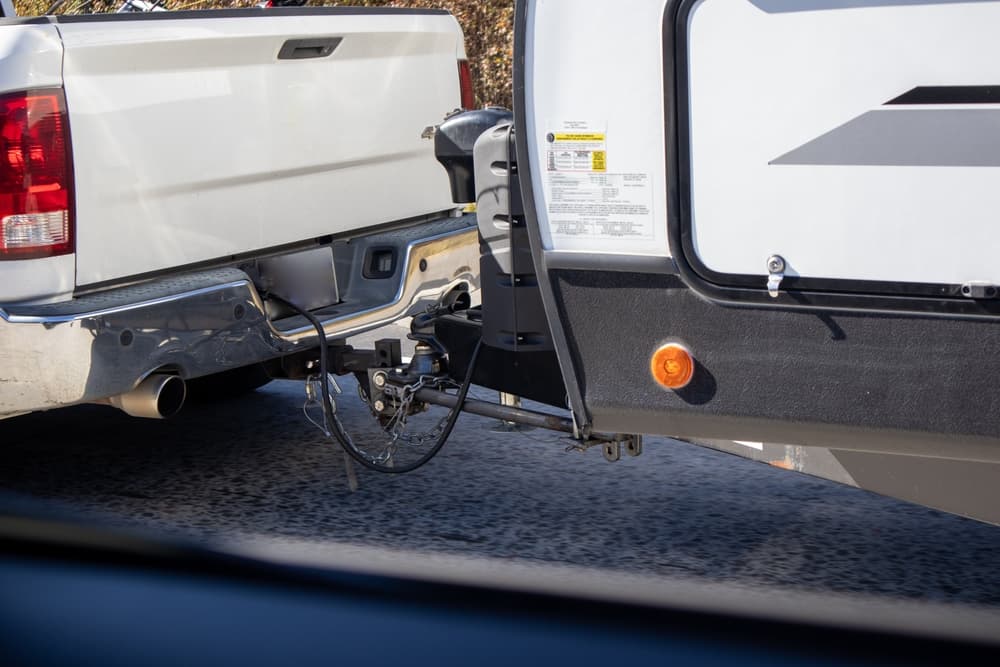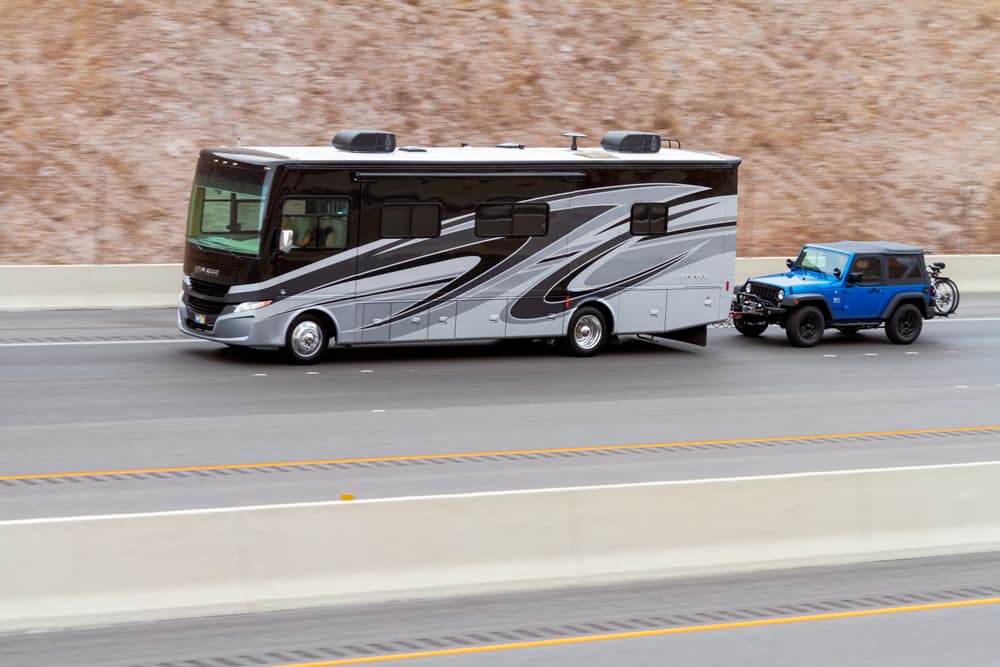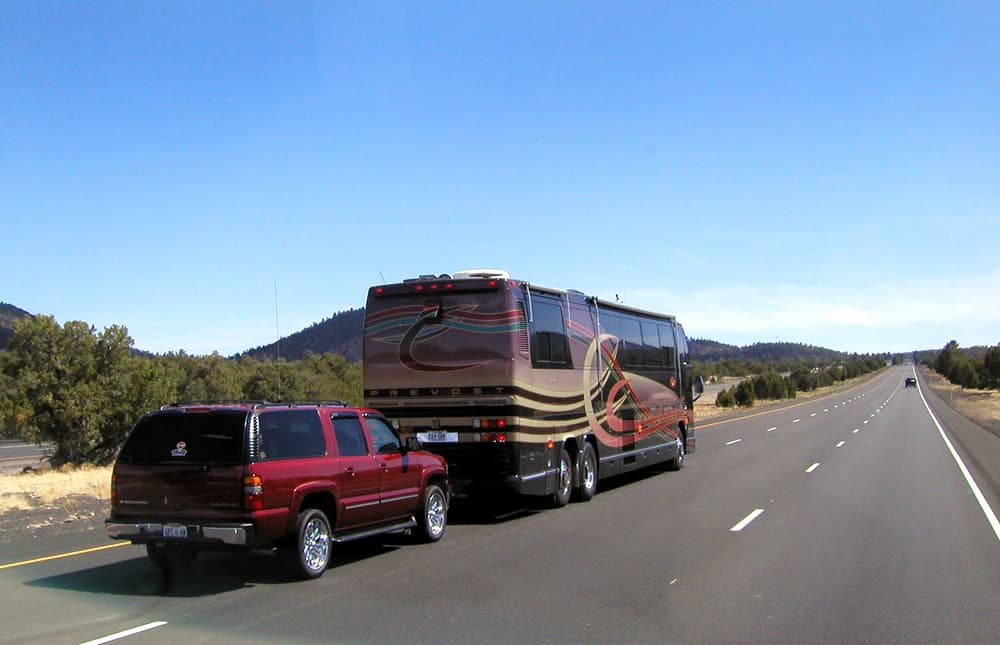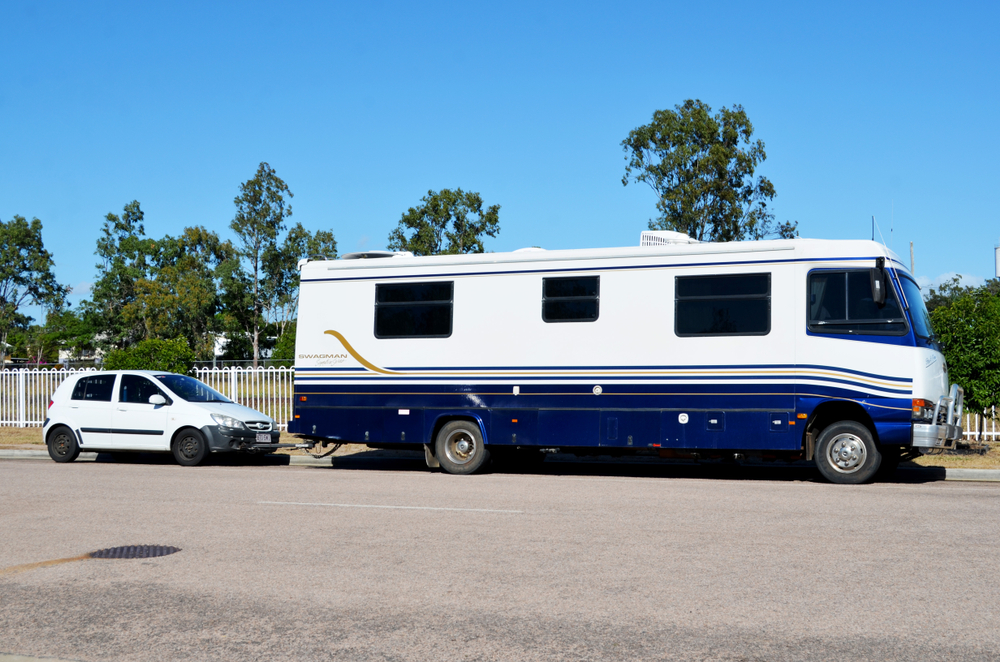In the United States, it’s not uncommon to see an RV pulling another car in the highway. However, this does not mean that all vehicles can or should be flat-towed, which is when all four wheels are on the ground.
Flat towing, commonly called “dinghy towing” because it resembles a huge boat dragging a smaller one, is not recommended for many cars, according to their manufacturers. When flat-towing is not an option, a trailer or tow dolly that elevates the front two wheels off the ground should be used to transport the car.
So what is flat towing and how can a vehicle be towed? We’ll break it down below.

What Is Flat Towing?
Flat towing is the practice of towing a vehicle with all four wheels on the ground instead of transporting it on a trailer or using a dolly to raise two wheels off the road. You need all-wheel drive (AWD), four-wheel drive (4WD), or a specific transmission for some vehicles before you can flat tow them.
Most RVs pull vehicles because, once the RV is parked, it’s simpler to get around town in a car or light truck than an RV. This is why so-called “dinghy vehicles” are frequently small cars or SUVs. Some large SUVs and full-size pickup trucks can also be flat-towed, provided the towing vehicle has enough power.
Is Flat Towing Legal?
Flat towing a car is legal. You are not breaking the law by flat towing your vehicle. Nonetheless, the majority of states mandate the use of a variety of safety precautions when doing so:
- Taillights: The towing vehicle’s lights must be clearly seen. Another option is to configure the tow vehicle’s taillights to react to the towing vehicle’s speed. This allows cars following you to receive the appropriate warnings and signals.
- License Plates: It is necessary to see the license plates of both the car being towed and the vehicle doing the towing.
- Chains: It is necessary to use safety chains. These offer an additional measure of security in case the main hitch malfunctions.

How to Flat Tow a Vehicle?
Because you don’t need to purchase or set up trailers or dollies, a flat tow is a rather easy method of towing a vehicle. If you have a car that can be safely towed, then a flat tow kit should have everything you need to perform the tow.
A flat tow kit contains most of the hardware essential for flat towing a car. If you purchase your towing equipment as a kit, you can realistically assume everything will function properly. Additionally, by doing it this way, you can be sure you have everything you need to perform a flat tow safely and legally.
What Vehicle Can Be Flat Towed?
It is recommended that you consult the owner’s manual of the vehicle in question to see whether or not it can be flat towed. Each make and model has different recommendations, and a car’s owner’s manual will explain whether it’s possible and, if so, how to do it. The original owner’s manual for your car can probably be found online if you don’t have it.
For a car to be appropriate for towing an RV, it must have the ability to disconnect the transmission, as opposed to simply being able to be placed in neutral. The transmission must be “disconnected.”
It’s also crucial to have a lockout override for the steering wheel. This prevents the wheels from turning in a different direction and enables them to move alongside the towing vehicle freely.
These are the most popular flat tow vehicles:
- Jeep Wrangler JL
- Ford F-150
- Jeep Wrangler JK
- Chevrolet Equinox
- Jeep Grand Cherokee
- Jeep Cherokee
- Chevrolet Colorado
- Honda CR-V
- GMC Terrain
- Jeep Wrangler TJ

Facts You Must Know
There are a few things you need to consider whether the towing vehicle is an RV, pickup, SUV, or something else:
- Find out how much weight the lead car can pull, and ensure the dinghy doesn’t exceed that. Cargo added to a dinghy vehicle increases its weight and must be accounted for.
- The towing vehicle must have a trailer hitch that can handle the load.
- Additionally, a tow bar that fits on the front of the dinghy and a base plate that mounts on the dinghy vehicle are required. Compared to unibody vehicles and crossovers, trucks and SUVs with body-on-frame construction are simpler to place base plates on.
- Get a wire kit to link the tow vehicle’s turn signals and brake lights to the boat.
- Towing specialists also advise auxiliary braking systems; in fact, most states mandate them for dinghy towing.
Do You Need Roadside Assistance?
Do you require immediate roadside assistance in the Bronx or nearby area? Bronx Towing Express is available around the clock to help with roadside emergencies such as flat tires, car lockouts, and dead batteries. We’re committed to responding promptly and efficiently.

